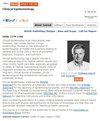Associations Between Estimated Pulse Wave Velocity and Five-Year All-Cause Mortality in Patients with Atherosclerotic Cardiovascular Disease with and without Standard Modifiable Risk Factors: Evidence From NHANES 1999-2016
IF 3.4
2区 医学
Q1 PUBLIC, ENVIRONMENTAL & OCCUPATIONAL HEALTH
引用次数: 0
Abstract
Aim: The study aimed to analyze the associations between estimated pulse wave velocity (ePWV) and 5-year mortality in atherosclerotic cardiovascular disease (ASCVD) patients with and without standard modifiable risk factors (SMuRFs), which included smoking status, hypertension, diabetes, and hypercholesterolemia.Methods: The present retrospective cohort study utilized data from the National Health and Nutrition Examination Survey (NHANES) between 1999 and 2016. Patients with ASCVD who completed both the questionnaire survey and serum testing were included. Patients were categorized into the ≥ 1 SMuRF group if they had at least one SMuRF, while those without any SMuRFs were classified into the SMuRF-less group. The ePWV, which was calculated using the age and mean blood pressure, was evenly divided into three categories: low (Q1), medium (Q2), and high (Q3). Multivariable weighted Cox proportional-hazard regression analyses were utilized to explore the risk factors associated with 5-year mortality in patients with and without SMuRFs. And restricted cubic spline curve (RCS) was used to assess their nonlinear correlation.
Results: A total of 1901 patients with ASCVD were included in the study. For the patients in ≥ 1 SMuRF group, the Q3 group included patients who were older, with a higher proportion of males, more comorbidities, and a lower body mass index than the Q1 group (P< 0.05). The Cox proportional-hazard regression model results revealed, the Q3 group had a higher risk of 5-year mortality than the Q1 group [hazard ratio (HR) 4.30, 95% confidence interval (CI) (2.66, 6.95), P< 0.001]. RCS demonstrated a linear trend between high level of ePWV and decreased risks of mortality. Similar results were observed in the SMuRF-less group [HR 10.62, 95% CI (1.22, 92.06), P=0.032].
Conclusion: A high level of ePWV signified a higher risk of 5-year mortality in ASCVD patients with and without SMuRFs.
Keywords: atherosclerotic cardiovascular disease, standard modifiable risk factors, estimated pulse wave velocity, all-cause mortality
有和无标准可改变风险因素的动脉粥样硬化性心血管疾病患者的估计脉搏波速度与五年全因死亡率之间的关系:来自 NHANES 1999-2016 的证据
目的:该研究旨在分析动脉粥样硬化性心血管疾病(ASCVD)患者的估计脉搏波速度(ePWV)与5年死亡率之间的关系,这些患者有无标准可改变风险因素(SMuRFs),包括吸烟状况、高血压、糖尿病和高胆固醇血症:本回顾性队列研究利用了 1999 年至 2016 年间美国国家健康与营养调查(NHANES)的数据。研究纳入了同时完成问卷调查和血清检测的 ASCVD 患者。如果患者至少有一个SMuRF,则被归入≥1 SMuRF组,而没有任何SMuRF的患者则被归入无SMuRF组。根据年龄和平均血压计算出的 ePWV 平均分为三类:低(Q1)、中(Q2)和高(Q3)。利用多变量加权 Cox 比例危险回归分析来探讨与 SMuRFs 患者和无 SMuRFs 患者 5 年死亡率相关的风险因素。并使用限制性立方样条曲线(RCS)评估其非线性相关性:研究共纳入 1901 名 ASCVD 患者。在 SMuRF ≥ 1 组患者中,Q3 组比 Q1 组年龄大、男性比例高、合并症多、体重指数低(P< 0.05)。Cox 比例危险回归模型结果显示,Q3 组的 5 年死亡风险高于 Q1 组[危险比 (HR) 4.30,95% 置信区间 (CI) (2.66, 6.95),P< 0.001]。RCS 显示,高水平 ePWV 与死亡风险降低之间呈线性趋势。在无 SMuRF 组也观察到类似结果[HR 10.62,95% CI (1.22,92.06),P=0.032]:关键词:动脉粥样硬化性心血管疾病;标准可改变危险因素;估计脉搏波速度;全因死亡率
本文章由计算机程序翻译,如有差异,请以英文原文为准。
求助全文
约1分钟内获得全文
求助全文
来源期刊

Clinical Epidemiology
Medicine-Epidemiology
CiteScore
6.30
自引率
5.10%
发文量
169
审稿时长
16 weeks
期刊介绍:
Clinical Epidemiology is an international, peer reviewed, open access journal. Clinical Epidemiology focuses on the application of epidemiological principles and questions relating to patients and clinical care in terms of prevention, diagnosis, prognosis, and treatment.
Clinical Epidemiology welcomes papers covering these topics in form of original research and systematic reviews.
Clinical Epidemiology has a special interest in international electronic medical patient records and other routine health care data, especially as applied to safety of medical interventions, clinical utility of diagnostic procedures, understanding short- and long-term clinical course of diseases, clinical epidemiological and biostatistical methods, and systematic reviews.
When considering submission of a paper utilizing publicly-available data, authors should ensure that such studies add significantly to the body of knowledge and that they use appropriate validated methods for identifying health outcomes.
The journal has launched special series describing existing data sources for clinical epidemiology, international health care systems and validation studies of algorithms based on databases and registries.
 求助内容:
求助内容: 应助结果提醒方式:
应助结果提醒方式:


